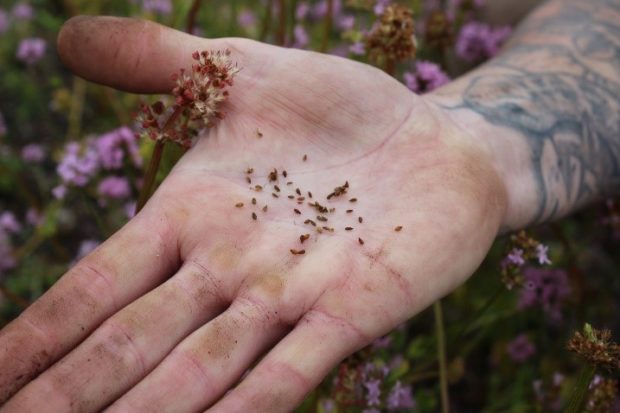Meet Sarah Larson, the new SPP Education Development Manager!
Sarah grew up in the South Puget Sound and considers Tacoma her hometown. Growing up in Washington, she has always been interested in the natural world. A few years after moving to Olympia, she learned about the Master of Environmental Studies (MES) program at The Evergreen State College. The program was a perfect fit, eventually bringing her to SPP in 2020 as the Program Operations Coordinator.

Sarah Larson and Carl Elliott load plants for the Conservation Nursery program at Washington Corrections Center for Women. Photo by Savannah Richard.
As the Program Operation Coordinator, Sarah assisted the SPP team with administrative tasks, reports, planning, and educational development. While she primarily worked at The Evergreen State College, she frequently supported other coordinators, helping with the butterfly, conservation nursery, and turtle programs, especially when the pandemic limited incarcerated technicians’ access to program areas. She helped ensure that endangered species like the Taylor’s Checkerspot Butterfly and Western Pond Turtle received vital care when technicians could not reach the program area. She really enjoyed working with other coordinators and supporting their programs, but it wasn’t until the incarcerated technicians were out of quarantine and able to work alongside her in the program areas that the full depth of the programs and what they mean became apparent.

Sarah Larson and Kelli Bush learn about the Sustainable Practices Lab composting program from Chris McGill at Washington State Penitentiary in Walla Walla. Photo by Carl Elliott.
During spring and summer of 2022, Sarah stepped in as the Sagebrush Program Coordinator. She worked with incarcerated technicians at Stafford Creek Corrections Center to grow native sagebrush for restoration projects in eastern Washington. She also delivered educational content, allowing technicians to earn academic credit from The Evergreen State College. She appreciated the opportunity to coordinate a program and work directly with incarcerated technicians.

Sagebrush growing in a hoop house at Stafford Creek Corrections Center. Photo by Sarah Larson.
In MES, Sarah studied a wide variety of topics. She earned her undergraduate degree in geology at WWU and focused on a variety of topics during the MES program, including flood mitigation in the Chehalis River basin and red alder nitrogen inputs to Puget Sound. Sarah points to some of the amazing people with ecology and botany backgrounds she met in her cohort that inspired her to complete a thesis on plants. Her thesis focused on herb Robert, a common invasive plant in the region, and worked to identify what mechanisms it may use to outcompete native species and establish itself in relatively intact habitats.
Sarah is now taking on a new role at SPP as the Educational Development Manager! She is excited to help design fun and engaging educational materials for incarcerated students and unconventional settings. She recognizes that SPP does not exist in a vacuum and is grateful to continue collaborating with and learning from the many SPP partners and other education providers. Most of all, she looks forward to learning more about prison education and how best to serve the population.
In her free time, Sarah enjoys being outdoors and anything involving plants or rocks! She also teaches environmental science and geology classes for Centralia College at Green Hill School and Cedar Creek Corrections Center. She loves traveling, hiking, and camping with her two children (especially if there are opportunities to see new plants)
















































